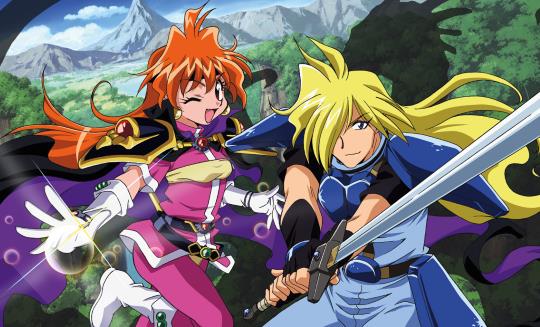Silver Screenings: Slayers

With the new design of GamerTagged.net will also come a new series of columns designed to encourage me to write more, at the very least as a “warm-up” to more substantial material. I’m also hoping the regular practice helps make it easier to “get into the writing mood” and further hones my knitting together of phrases, words, and sentences. Giving people more reasons to actually check the site regularly helps, too.
I had fully intended to jump into something a bit more modern after watching Vision of Escaflowne. I had spent an entire week on the topic of nostalgia and wasn’t looking to push the topic any further.
At the same time, I was really sick of seeing that shiny plastic covering my Slayers DVD box set. So I peeled the cellophane away, popped the case open, and plopped the first disc into the tray for casual viewing. Bewitched, this quick trip into a twenty-plus year-old anime became a nightly habit of my brother and I following sorceress Lina Inverse along her adventures.
My first exposure to the series had been in my early teens, before I knew there was even an option to watch anime in its native language. Such VHS cassette tapes were largely special orders, further increasing their rarity. It wasn’t until my siblings and I had ventured into the dark corners of the Echelon Mall (now rebranded as Voorhees Town Center, evidently) that we uncovered “fansubbed” editions of anime, containing episodes of Dragon Ball Z that wouldn’t release in the states until Funimation obtained the rights to the series. Thus began my gradual preference to watch any piece of artistic media in its native language – going so far as to have me pondering a playthrough of The Witcher 3 in Polish rather than English*.
I want to make it clear that this preference isn’t necessarily due to a perception that American voicework is inferior, and at times I’m actually fine with the dub. For example, I like Xenoblade Chronicles’ English voicework a surprising amount. I think it’s some of the best you can see in regards to localization, and the same goes for Lisa Ortiz and her impressive work done with Lina Inverse in Slayers.
Unfortunately, the nature of the anime medium means any Western voice actor has a lot of factors working against them. Being forced to adjust your delivery to match the flapping gums of characters animated to fit a completely different language is just the beginning. Time constraints and lack of instruction from the Japanese director often result in guesswork and interpretation rather than accurate translation. It’s why a conceited prince of space is transformed into an older woman.
It’s easy to say “I prefer the original language because the translation is as close to the original translation as possible”, but it’s important to understand that any translation is limited in how literal it can be. Dialect and slang must be accounted for, and sometimes you can only find an approximation of a word in the language being localized to. There will always be something lost in translation, and this is as true for classic works such as The Iliad and its natively poetic prose as it is for anime. Consider for a moment that both Greek and Japanese have various words for different kinds of love than English and you can begin to see where liberties have to be taken in order to get the spirit across.
As a result, from a consumer standpoint there are ideally two types of subtitled work. The first is, in video games at least, most common: the text transcription of the English dub. Ideally, however, if I select the Japanese voice track, the subtitles will be a more accurate translation that does not need to take lip syncing and other modifications necessary for a dub into account. This can make a surprisingly big difference, but unfortunately games such as Nier: Automata and Drakengard 3 only provide the English dub transcript.
“What does this have to do with Slayers, man?”
I suppose because I’d feel bad explaining my preference for watching Slayers in Japanese if I didn’t make it clear that it’s not a simple dismissal of the efforts Lisa Ortiz put into voicing Lina. If I’m honest, however, I feel like Megumi Hayashibara’s performance is nothing short of being a treasure. The woman has done a surprising number of iconic characters I’m familiar with, including Evangelion’s Rei Ayanami and the female transformation of titular Ranma 1/2’s Ranma Saotome. I’ve been familiar with all three of these characters in English first, but with Lina Inverse Megumi Hayashibara really showcases her talents in a way I don’t think an English dub could permit.
Which is why I feel any film or show – be it Asian, European, Latin American, what have you – is just going to lose something in a dub, no matter the quality of the voicework. Listen to the manner in which Lina freaks out to Noonsa the fish man. Lisa Ortiz did a good job as well, but the manner in which Megumi Hayashibara flips out is… well, it feels varied, it feels as unexpected as it also feels predictable, it feels as if they unleashed an actual cockroach in the soundbooth… The differences are subtle, but Lina was written and directed with a Japanese voice in mind, and Megumi delivers it in a way that outclasses so much voicework in both English and Japanese.
Which is probably why I feel so strongly regarding this topic. I don’t think it’s a matter of English voice talent versus Japanese. I don’t think many Japanese voice actresses would have been able to do as good a job with Lina Inverse as Megumi had managed, and that voice is essential to what makes Lina who she is.
Or at least, is part of what makes Lina who she is.
In keeping with my discussion of anything but the anime this column, I need to diverge a bit into Shamus Young and Shawn Gaston’s short-lived Chainmail Bikini, a comic in which a group of awful people try and play D&D together. A sort-of continuation of Young’s DM of the Rings, the intentions are to lampoon tabletop roleplaying systems, tabletop roleplayers, and – in the latter’s case – The Lord of the Rings as interpreted as a D&D game. This concept was later carried on by Darths & Droids, replacing The Lord of the Rings with Star Wars.
These comics delight the reader by shining a light directly on the absurdity of player and game logic juxtaposed against traditional narratives. At its most optimistic, tabletop role-playing games allow players to live out their own epic narratives driven by their own actions and imaginations. In execution, the narrative becomes a complete mess of mistakes, dumb decisions, sociopathic characters, and idiot-savants bumbling their ways into heroism and victory.

Such a description feels nearly suitable for Slayers itself, though its characters aren’t quite that deplorable. If those comics interpret epic narratives through tabletop gameplay, Slayers reconstitutes those spoofs back into a traditional story. Lina Inverse is obsessed with collecting treasure in as selfish a manner as players are. Her second episode exploit to transform junk jewelry into a top-class gem feels like the sort of monotonous, game-breaking tedium a player would “take twenty” to complete. Lina seems confused when the villagers are angry that her dragon slaying spell also happened to fell their homes, just as players seem oblivious to the feelings and lives of NPCs.
What differentiates the characters of Slayers from those in the spoof comics is the lack of a GM. The only reason players do what is right – at least, in the above listed spoof comics – is because the DM effectively twists their arm into following his railroaded plot. Lina and her compatriots may be treasure hunger, but they’re also compassionate enough that they’d rather not allow the evil god of darkness and doom to rip the world asunder.
This, I think, is what really warms the heart to characters like Lina, Gourry, Amelia, Sylphiel and Zelgadis. The more clever ones are a bit selfish or mean, the good-natured ones are a bit dumb, and they all seem to leave as much devastation in their wake as they do good deeds.
Perhaps that’s all in thanks to a third secret ingredient to Slayers. Megumi Hayashibara’s voice work gives Lina a vibrant vitality that few could manage, and the tabletop gaming lense gives the characters flaws and narratives an absurdity that will constantly amuse. I must wonder if, all things told, it is the Japanese concept of Wa that makes such characters endearing.
Today’s Western media is polluted with self-destructive narcissists masquerading as heroes. They appeal to the voyeuristic desires to watch someone’s train wreck of a life, later gossiping about their choices and self-imposed misery over water coolers at work. In order to maintain ratings and keep the show progressing, the character must continue to bury themselves deeper and deeper into the muck of bad decisions, dragging as many possible down with them.
Yet in Slayers, no matter how many bandits Lina steals from and no matter how dark the spells she casts in order to preserve herself, there’s at least that concept of greater harmony that must be maintained. A core to Japan’s culture that America’s love of individual heroism lacks.
Perhaps that’s why I not only enjoy Slayers more than I had when I first watched it twenty years ago. Those exotic, foreign traits are able to combine with the familiar into a much more optimistic and unique whole that just would not have taken the same shape if formed by Western hands.
*This is a whole other can of worms to discuss another day.


